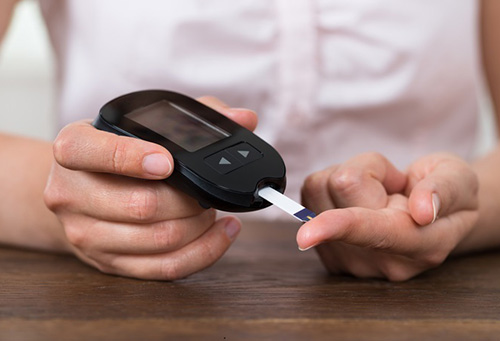The diet for people with type 2 Diabetes improves their metabolism and slows down the development of diabetes
Many people have type 2 diabetes for years before their early symptoms can be spotted and many don’t even realize they are at risk. The earlier type 2 diabetes is detected, the better chance a person has to manage the disease.
More than 4.9 million people in the UK have diabetes and it is estimated that there are thousands of cases that are not yet diagnosed. The NHS has now made it much easier to do a self-test with your doctor to find out if you have diabetes or another type of condition that means you need medication, such as high blood pressure, kidney problems, or heart disease.
Type 2 diabetes is far more common than type 1 and accounts for around 90% of all adult cases in the UK, while only 8%, according to Diabetes UK, have type 1. Type 2 diabetes is characterized by a resistance to insulin and affects the way that the body processes glucose.
More than 6 million people are at increased risk of developing type 2 diabetes, and more than 750,000 people are currently living with the condition but are not aware of it.
Research has shown that one of the most effective ways to reduce your risk of developing Type 2 Diabetes is by making some lifestyle changes. These changes may include diets, exercise, and weight loss to help reduce your risk by as much as 50%.
EARLY DIAGNOSIS IS KEY
Health professionals emphasize early diagnosis is key as the early stages of this disease often span five or maybe six years before symptoms become noticeable. This is why it’s so important to be aware of the indicators to detect type 2 diabetes as soon as possible and take the necessary steps to prevent any complications.
Type 2 diabetes is a lifelong condition that is typically caused when insulin isn’t produced in balance with the body’s needs and can often be linked to being overweight, being too sedentary, or having a family history of type 2 diabetes. Type 2 diabetes can cause health complications like increased blood sugar levels, cardiovascular disease, kidney damage, nerve damage, and blindness
It can cause the level of glucose in the blood to become too high and this can lead to a variety of serious health conditions, including heart disease or a stroke.
A variety of lifestyle adjustments and medical interventions are required for people with Diabetes to live a long and healthy life. In order to maintain balanced blood sugar levels, people who have diabetes should exercise, eat healthily, and have their blood tests checked regularly. The lifelong nature of diabetes also often requires people who have type 1 diabetes to take insulin injections on a regular basis.
As type 2 diabetes is a gradually developing condition, medicine, at some point in time, may be required and this will normally be in the form of tablets or injections.
If you are a person with this condition, you are more at risk of developing it. The earlier you recognize these warning symptoms, the earlier you will be able get in control. You should monitor the following points:
– people are over 40 or 25 for south Asian people.
– A close relative of a parent, brother. or another family member with diabetes who may be able to provide this information.
– if your weight is higher than the prescribed weight for your build and size.
– if you are or your family comes from any of these locations of Asian, African of the Caribbean, or black African origin
You can find out your risk for type 2 diabetes by answering a few questions from your health provider. You can get help with your Diabetes Prevention program if your risk score is dependent on it.
BE SMART AND GET CHECKED
Many people, even those who are not diabetic and do not know they currently have the condition, are unaware that they have been diagnosed with diabetes because it can exist with no symptoms which makes it difficult to spot.

However, it is important to keep in mind a few key symptoms that may indicate the condition. The main symptoms of ovulation, according to the NHS, include:
– going to the washroom more than usual, particularly at night
– feeling thirsty all through the day
– feeling very tiring.
– your weight is dropping and you’re not trying to lose weight
– itching around the penis or vagina or symptoms of thrush.
– healing time for wounds is longer than normal
– your vision begins to degrade
Type 1 diabetes, often referred to as “juvenile diabetes” can develop quickly over weeks and is typically diagnosed around the time of puberty.
Both type 1 and type 2 diabetes can be diagnosed by means of either a blood or urine test.
If you have been diagnosed with Type 1 Diabetes, a diabetes nurse will be able to show you how to manage the condition in your day-to-day life, including learning how to test your blood glucose and inject insulin.
CHANGING LIFESTYLE IS KEY
Your doctor should discuss other lifestyle factors, such as alcohol consumption and smoking, in addition to your diet and exercise habits. They will also determine whether you might need to take medications.
Most people diagnosed with diabetes need to take medicine to control blood sugar levels and get close to normal. In those with type 1 diabetes, insulin must be taken every day for the same purpose.
Some types of diabetes medications can lead to a condition known as hypoglycemia or low blood sugar. This happens when blood sugar levels drop below a certain level, when this happens, your doctor should ask you to check your blood sugar by taking regular tests with a glucose monitoring device.
If you have frequent or severe hypos where you usually take the blood test twice a day, you could be offered a continuous glucose monitor or flash monitor which would be worn on your skin and allow you to check your blood sugars at any time.
A healthy diet of around 2.5 hours of physical activity each week can help with blood sugar levels. Fruit, vegetables, and pasta are high in sugar, fat, and salt, so the National Health Service recommends not eating any of them.
There is mounting evidence that a low-calorie diet (800 to 1,200 calories a day) can be used as an effective treatment for type 2 diabetes. Some people have even gone into remission by following this low-calorie diet for around 12 weeks at a time. Remember, the earlier you recognize these warning symptoms, the earlier you will be able get in control.
H/T: @NationalWorld
Fasting Mimicking diet has become a hot topic of nutrition recently because it improves health for people with type 2 diabetes.
Recent studies show that abstention from eating food for a period of time might have a variety of health benefits, including weight management, diabetes, and cancer risk reduction. Various diet programs were created to incorporate the fast mimicking diet, which is gaining popularity these days. The idea behind it is to make the body think that it is fasting despite it is not. So, what is the purpose of a fasting-mimicking diet?
Intermittent and fasting-mimicking diets are the two main types of fasting diets. The former is an eating plan where you change from fast to eating during certain hours. Fasting-mimicking is more detailed about when and how many calories can be eaten. A fast-mimicking diet is less difficult to gain the benefits of fast, according to US News. Process fools the body into it is not eating or drinking for five days. Dr. Valter Longo created a plan to find a balance between eating more than needed and not enough. Dr. Longo over saw in-depth research into the topic of food restriction and what it could do for longevity and health. He formulated the ProLon Fasting Mimicking Diet based on his research after founding the L-Nutra technology company.
FASTING CAN WORK
Researchers found in a recent study that the six-month intermittent fast in patients with type 2 diabetes enhances metabolism and reduces the progression of the disease. The Fasting-Mimicking Nutrition Program is safe if there is a combination of personalized nutrition consultation and could be implemented into clinical practice, as reported by the company’s press release. The program is suited to people with type 2 diabetes who are not happy with keeping their blood pressure in check using medicines and people who wish to have their condition completely out of sight and out of mind.

Amy Burkhart’s blog post shared that Dr. Longo and his team at the Longevity Institute at The University of Southern California have been working with “chemical pathways” that regulate the structure of the body. The autophagy of cells keeps them living and in a high level of energy, as well as removing failing cells that can cause sickness and increase aging. A fast-miming diet speeds up the process, meaning less clean-up is taking place, which can result in less risk of health problems.
In addition, nutrient-sensing pathways, and how the environment affects the genes are involved in the epigenetic expression. Epigenetic expression and how the environment shapes the genes are some factors that are also involved. One person gets a disease while the other is unaffected by it. The five-day plan was created by the team to promote autophagy in the body’s cells. They say it is a good idea to do it every up to 6 months to keep its benefits. The diet for people with type 2 Diabetes improves their metabolism and slows down the development of diabetes.
Please join our Facebook group and check out our other blog articles.
H/T Source: Science Times







